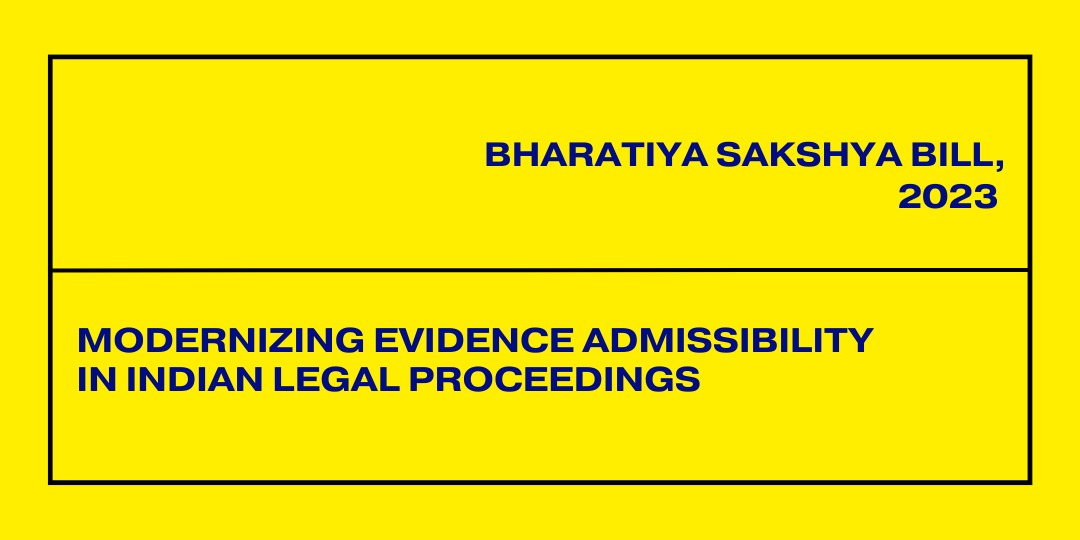Bharatiya Sakshya Bill, 2023 Modernizing Evidence Admissibility in Indian Legal Proceedings

Vijay M, Associate, Dispute Resolution Practice
Introduction:
The Bharatiya Sakshya Bill, 2023[1], recently introduced in the Parliament, aims to revolutionize the way evidence is admitted in Indian legal proceedings. This ambitious legislation seeks to replace the long-standing Indian Evidence Act, 1872[2], along with two other bills aimed at reforming the Indian Penal Code, 1860[3], and the Code of Criminal Procedure, 1973[4]. This article delves into the significant changes proposed by the Bill and provides a critical analysis of its potential impact on the Indian legal system.
One of the most noteworthy aspects of the Bharatiya Sakshya Bill is its approach towards consolidation and modernization. The Bill consolidates various definitions and concepts, streamlining the understanding of terms like ‘conclusive proof’, ‘may presume’, and ‘shall presume’. Additionally, it introduces a provision for interpreting undefined terms by referencing the Information Technology Act, 2000[5], Bharatiya Nagarik Suraksha Sanhita, 2023[6], and Bharatiya Nyaya Sanhita, 2023[7].
Admissibility of Electronic and Digital Records:
The Bill pays special attention to electronic evidence, recognizing the expertise of examiners of electronic evidence as per Section 79A of the IT Act[8]. This provision emphasizes the relevance of digital evidence, aligning it with the evolving technological landscape. Section 61[9], Section 62[10] and Section 63[11] deals with the admissibility of Electronic and Digital Records, whereby it connotes:
61. Nothing in the Adhiniyam shall apply to deny the admissibility of an electronic or digital record in the evidence on the ground that it is an electronic or digital record and such record shall have the same legal effect, validity and enforceability as paper records.
62. The contents of electronic records may be proved in accordance with the provisions of section 59.
Section 59[12] states that documents shall be proved by primary evidence except in cases where the secondary evidence is permissible. Also, under section 63 it mentions any information contained in an electronic record (computer output) can be considered a document if certain conditions are satisfied.
These conditions include:
- The computer output was produced by the computer or communication device during a period when the computer was regularly used for creating, storing, or processing information for a specific activity.
- Information similar to that contained in the electronic record was regularly fed into the computer during the ordinary course of activities.
- The computer or communication device was operating properly during the relevant period, or any malfunction did not affect the electronic record or its accuracy.
- The information in the electronic record reproduces or is derived from the information fed into the computer during the ordinary course of activities.
If multiple computers or communication devices were used for the same purpose over a period, they are treated as a single computer for the purposes of this provision.
In any legal proceeding where a statement from an electronic record is desired to be used as evidence, a certificate must be submitted with the electronic record. This certificate should:
- Identify the electronic record and describe how it was produced.
- Provide particulars of any devices involved in the production of the electronic record.
- Address matters related to the conditions mentioned in subsection (2), and be signed by a person in charge of the computer or communication device and an expert.
Sections 59, 60, and 61 together establish the framework for the admissibility of electronic records as evidence in legal proceedings. Given these provisions, it appears that electronic evidence, as described in Section 61, can be admitted without the need for special proof under Section 63.
Based on both these non-obstante provisions, it suggests that electronic evidence can be admitted in proceedings without further proof or production of the original, if the conditions mentioned in section 63 are satisfied. This means that, under these conditions, electronic evidence stands valid on its own as primary evidence and does not need to be separately proven according to Section 63. The question here is that what does section 62 provide for in the bill, since it’s title as special provision as to evidence relating to electronic record, directly hinders section 61 and 63. The fact that Section 61 specifically addresses electronic records and provides for their admissibility seems like it serves as a specific provision that prevails over general provisions like Section 59. But the above provisions warrant clarifications since the non-obstante provisions hinder each other.
Certification by an Expert:
Section 63 (4)(c)[13] outlines the procedure for submitting a certificate, signed by the person in charge of the computer or communication device along with an expert, for any matter related to the conditions in subsection (2)[14]. The certificate serves as evidence and is required to be stated to the best of the knowledge and belief of the person providing it. Under Section 63(2)[15] specific conditions for a computer output to be considered admissible as evidence. These conditions encompass the regular use of the computer, the consistent feeding of information, proper operation, and faithful reproduction of information.
While both 65B of the Act[16] and 63 (4)(c) of the Bill require a certificate, the proposed Bill specifies that it should be signed by a person in charge of the computer or communication device and an expert (whichever is appropriate). Requiring an expert’s certificate at the stage of admissibility, particularly for a matter related to deriving a computer output, introduces an unnecessary layer of complexity in admitting evidence. This mandate makes it counterproductive to the intended purpose of facilitating electronic evidence presentation. The distinction made between the admissibility of the document itself and the potential need for an expert to analyze electronic evidence for signs of tampering or alteration is significant. The current provisions appear to combine these two aspects, potentially complicating the process unnecessarily. Distinguishing between the admissibility of the document and the potential need for expert analysis could enhance the practicality of the process. By doing so, the legal framework could better facilitate the presentation of electronic evidence without compromising its authenticity.
Broadening Secondary Evidence:
The addition of section 58[17] build upon the provision of the Act, significantly expanding the scope of secondary evidence by including oral and written admissions, and involving expert examiners[18]. Section 58 of the Bill states as follows,
–” Secondary evidence includes— (1) certified copies given under the provisions hereinafter contained; (2) copies made from the original by mechanical processes which in themselves ensure the accuracy of the copy, and copies compared with such copies; (3) copies made from or compared with the original; (4) counterparts of documents as against the parties who did not execute them; (5) oral accounts of the contents of a document given by some person who has himself seen it; (6) oral admissions; (7) written admissions; (8) evidence of a person who has examined a document, the original of which consists of numerous accounts or other documents which cannot conveniently be examined in Court, and who is skilled in the examination of such documents.”–
The newly introduced bill significantly expands the definition of secondary evidence compared to the existing act. Under this bill, secondary evidence now encompasses certified copies, mechanically reproduced copies, copies made from or compared with the original, counterparts of documents, oral and written admissions. The bill introduces the provision for an expert examiner to provide evidence regarding documents that consist of numerous accounts or documents that cannot be conveniently examined in Court The bill explicitly addresses the admissibility of secondary evidence when the genuineness of a document is in question. The bill complements the provisions of the existing act rather than contradicting them potentially benefiting parties who may face challenges in producing original documents. The provisions regarding mechanically reproduced copies can be crucial in cases where the accuracy of the reproduction method may be in question.
Conclusion:
The provisions concerning ‘Admissions of electronic evidence’ largely mirror those of the existing Evidence Act. While there are some structural changes, the substance remains unchanged. The expansion of secondary evidence under Section 58 is a positive development, incorporating oral and written admissions, as well as evidence from a skilled person. This expansion is expected to enhance the admissibility of documents, providing courts with a broader spectrum of evidence. The requirement of an expert’s certificate for admissibility of electronic evidence may inadvertently create undue hardships for individuals seeking to present such evidence. While the Bharatiya Sakshya Bill, 2023, demonstrates commendable efforts in modernizing evidence admissibility, certain provisions, particularly those related to confessions, need close scrutiny. Striking a balance between technological advancements and ease of admissibility remains a crucial challenge in this endeavor. The Bill’s impact on the legal process will ultimately be determined by how its provisions are applied in practice and interpreted by the courts.
[1] Bharatiya Sakshya Bill, 2023, Bill No. 123 of 2023 (India).
[2] Indian Evidence Act, 1872, No. 1 of 1872, Acts of Parliament, 1872 (India).
[3] Indian Penal Code, 1860, Act No. 45 of 1860, Acts of Parliament, 1860 (India).
[4] Code of Criminal Procedure, 1973, Act No. 2 of 1974, Acts of Parliament, 1974 (India).
[5] Information Technology Act, 2000, Act no. 21 of 2000, Act of Parliament, 2000 (India).
[6] The Bharatiya Nagarik Suraksha Sanhita, 2023, Bill No. 122 of 2023 (India).
[7] Bharatiya Nyaya Sanhita, 2023, Bill No. 121 of 2023 (India).
[8]Information Technology Act, 2000, § 79A, Act no. 21 of 2000, Act of Parliament, 2000 (India).
[9] Bharatiya Sakshya Bill, 2023, § 61, Bill No. 123 of 2023 (India).
[10] Bharatiya Sakshya Bill, 2023, § 62, Bill No. 123 of 2023 (India).
[11] Bharatiya Sakshya Bill, 2023, § 63, Bill No. 123 of 2023 (India).
[12] Bharatiya Sakshya Bill, 2023, § 59, Bill No. 123 of 2023 (India).
[13] Bharatiya Sakshya Bill, 2023, § 63(4)(c), Bill No. 123 of 2023 (India).
[14] Bharatiya Sakshya Bill, 2023, § 63(2), Bill No. 123 of 2023 (India).
[15] Ibid.
[16] Indian Evidence Act, 1872, § 65B, No. 1 of 1872, Acts of Parliament, 1872 (India).
[17] Bharatiya Sakshya Bill, 2023, § 58, Bill No. 123 of 2023 (India).



